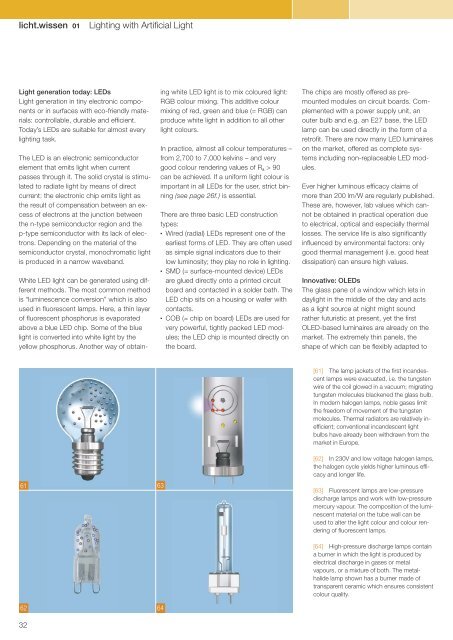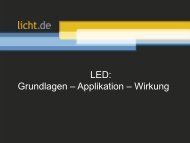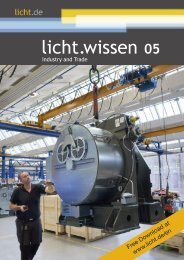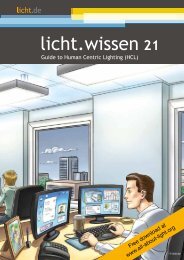licht.wissen No. 01 "Lighting with Artificial Light"
Booklet 1 is intended for all those who want to delve into the topic of light and lighting or wish to familiarize themselves with the basics of lighting technology. It also helps to make a decision in the field of lighting. Free Download at www.licht.de/en
Booklet 1 is intended for all those who want to delve into the topic of light and lighting or wish to familiarize themselves with the basics of lighting technology. It also helps to make a decision in the field of lighting. Free Download at www.licht.de/en
Create successful ePaper yourself
Turn your PDF publications into a flip-book with our unique Google optimized e-Paper software.
<strong>licht</strong>.<strong>wissen</strong> <strong>01</strong><br />
<strong>Lighting</strong> <strong>with</strong> <strong>Artificial</strong> Light<br />
Light generation today: LEDs<br />
Light generation in tiny electronic components<br />
or in surfaces <strong>with</strong> eco-friendly materials:<br />
controllable, durable and efficient.<br />
Today’s LEDs are suitable for almost every<br />
lighting task.<br />
The LED is an electronic semiconductor<br />
element that emits light when current<br />
passes through it. The solid crystal is stimulated<br />
to radiate light by means of direct<br />
current: the electronic chip emits light as<br />
the result of compensation between an excess<br />
of electrons at the junction between<br />
the n-type semiconductor region and the<br />
p-type semiconductor <strong>with</strong> its lack of electrons.<br />
Depending on the material of the<br />
semiconductor crystal, monochromatic light<br />
is produced in a narrow waveband.<br />
White LED light can be generated using different<br />
methods. The most common method<br />
is “luminescence conversion” which is also<br />
used in fluorescent lamps. Here, a thin layer<br />
of fluorescent phosphorus is evaporated<br />
above a blue LED chip. Some of the blue<br />
light is converted into white light by the<br />
yellow phosphorus. Another way of obtaining<br />
white LED light is to mix coloured light:<br />
RGB colour mixing. This additive colour<br />
mixing of red, green and blue (= RGB) can<br />
produce white light in addition to all other<br />
light colours.<br />
In practice, almost all colour temperatures –<br />
from 2,700 to 7,000 kelvins – and very<br />
good colour rendering values of R a > 90<br />
can be achieved. If a uniform light colour is<br />
important in all LEDs for the user, strict binning<br />
(see page 26f.) is essential.<br />
There are three basic LED construction<br />
types:<br />
<br />
Wired (radial) LEDs represent one of the<br />
earliest forms of LED. They are often used<br />
as simple signal indicators due to their<br />
low luminosity; they play no role in lighting.<br />
<br />
SMD (= surface-mounted device) LEDs<br />
are glued directly onto a printed circuit<br />
board and contacted in a solder bath. The<br />
LED chip sits on a housing or wafer <strong>with</strong><br />
contacts.<br />
<br />
COB (= chip on board) LEDs are used for<br />
very powerful, tightly packed LED modules;<br />
the LED chip is mounted directly on<br />
the board.<br />
The chips are mostly offered as premounted<br />
modules on circuit boards. Complemented<br />
<strong>with</strong> a power supply unit, an<br />
outer bulb and e.g. an E27 base, the LED<br />
lamp can be used directly in the form of a<br />
retrofit. There are now many LED luminaires<br />
on the market, offered as complete systems<br />
including non-replaceable LED modules.<br />
Ever higher luminous efficacy claims of<br />
more than 200 lm/W are regularly published.<br />
These are, however, lab values which cannot<br />
be obtained in practical operation due<br />
to electrical, optical and especially thermal<br />
losses. The service life is also significantly<br />
influenced by environmental factors: only<br />
good thermal management (i.e. good heat<br />
dissipation) can ensure high values.<br />
Innovative: OLEDs<br />
The glass pane of a window which lets in<br />
daylight in the middle of the day and acts<br />
as a light source at night might sound<br />
rather futuristic at present, yet the first<br />
OLED-based luminaires are already on the<br />
market. The extremely thin panels, the<br />
shape of which can be flexibly adapted to<br />
[61] The lamp jackets of the first incandescent<br />
lamps were evacuated, i.e. the tungsten<br />
wire of the coil glowed in a vacuum; migrating<br />
tungsten molecules blackened the glass bulb.<br />
In modern halogen lamps, noble gases limit<br />
the freedom of movement of the tungsten<br />
molecules. Thermal radiators are relatively inefficient;<br />
conventional incandescent light<br />
bulbs have already been <strong>with</strong>drawn from the<br />
market in Europe.<br />
61<br />
62<br />
32<br />
63<br />
64<br />
[62] In 230V and low voltage halogen lamps,<br />
the halogen cycle yields higher luminous efficacy<br />
and longer life.<br />
[63] Fluorescent lamps are low-pressure<br />
discharge lamps and work <strong>with</strong> low-pressure<br />
mercury vapour. The composition of the luminescent<br />
material on the tube wall can be<br />
used to alter the light colour and colour rendering<br />
of fluorescent lamps.<br />
[64] High-pressure discharge lamps contain<br />
a burner in which the light is produced by<br />
electrical discharge in gases or metal<br />
vapours, or a mixture of both. The metalhalide<br />
lamp shown has a burner made of<br />
transparent ceramic which ensures consistent<br />
colour quality.

















